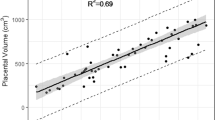Abstract
Purpose
Complex fetal behavior involving multiple parts of the body, called general movement (GM), has been considered an essential predictor of neurological functional development because it directly reflects the integrity of the brain and central and peripheral nervous systems. We have developed a novel method for quantitative analysis of fetal behavior using four-dimensional ultrasound (4DUS) and conducted a pilot study for quantitative assessment of fetal GM in the early second trimester.
Methods
All subjects underwent 4DUS to depict the whole fetal body, and maximum velocity (MAXV), median velocity (MV), average velocity (AV), and mode velocity (MOV) were calculated by utilizing optical flow analysis. Receiver operating characteristic (ROC) curve analysis was performed to analyze the optimal speed parameters for detecting GM in the fetus. The Mann–Whitney U test was used to validate MAXV, AV, and MV ability to detect fetal GM.
Results
The presence of fetal GMs and the absence of fetal GMs were 226 and 107, respectively, based on optical flow analysis. Mann–Whitney U test revealed a significant difference in the presence or absence of fetal GM in MAXV, MV, AV, and MOV. ROC analysis showed that the area under the curve (AUC) of MAXV was 0.959; the threshold was 0.421, the sensitivity was 86%, and the specificity was 93%. In contrast, the AUC/threshold for AV and MV was 0.700/0.110 (sensitivity 71% and specificity 76%) and 0.521/0.119 (sensitivity 21% and specificity 90%), respectively. Spearman's rank correlation analysis also showed a weak negative correlation between GM and MAXV (r = − 0.235, P < 0.01) and AV (r = − 0.28, P < 0.01).
Conclusion
In this study, we conducted a quantitative analysis of fetal behavior based on optical flow using 4DUS and demonstrated that it was highly accurate for detecting GMs and for evaluating developmental changes in GMs. The implementation of quantitative analysis of fetal GMs in the early second trimester has been very preliminary, and there is much debate on how it will be clinically applied to perinatal assessment.







Similar content being viewed by others
References
Einspieler C, Prechtl H, Ferrari F, et al. The qualitative assessment of general movements in preterm, term and young infants—review of the methodology. Early Human Dev. 1997;50:47–60.
Prechtl H. Qualitative changes of spontaneous movements in fetus and preterm infant are a marker of neurological dysfunction. Early Human Dev. 1990;23:151–8.
de Vries J, Visser G, Prechtl H. The emergence of fetal behaviour. I. Qualitative aspects. Early Hum Dev. 1982;7:301–22.
Kurjak A, Andonotopo W, Hafner T, et al. Normal standards for fetal neurobehavioral developments–longitudinal quantification by four-dimensional sonography. J Perinat Med. 2006;34:56–65.
Kuno A, Akiyama M, Yamashiro C, et al. Three-dimensional sonographic assessment of fetal behavior in the early second trimester of pregnancy. J Ultrasound Med. 2001;20:1271–5.
Hata T. Current status of fetal neurodevelopmental assessment: four-dimensional ultrasound study. J Obstet Gynaecol Res. 2016;42:1211–21.
Kanenishi K, Hanaoka U, Noguchi J, et al. 4D ultrasound evaluation of fetal facial expressions during the latter stages of the second trimester. Int J Gynaecol Obstet. 2013;121:257–60.
Sajapala S, AboEllail M, Kanenishi K, et al. 4D ultrasound study of fetal movement early in the second trimester of pregnancy. J Perinat Med. 2017;28(45):737–43.
Abo-Yaqoub S, Kurjak A, Mohammed AB, et al. The role of 4-D ultrasonography in prenatal assessment of fetal neurobehaviour and prediction of neurological outcome. J Matern Fetal Neonatal Med. 2012;25:231–6.
Gelo O, Braakmann D, Benetka G. Quantitative and qualitative research: beyond the debate. Integr Psychol Behav. 2008;42:266–90.
Barron J, Fleet D, Beauchemin S. Performance of optical flow techniques. Int J Comput Vis. 1994;12:43–77.
Farnebäck G. Two-frame motion estimation based on polynomial expansion. Berlin: Springer; 2003. p. 363–70.
Zhang Y, Zheng J, Zhang C, et al. An effective motion object detection method using optical flow estimation under a moving camera. J Vis Commun Image Represent. 2018;55:215–28.
Ueda H, Yokota E, Kutsuna N, et al. Myosin-dependent endoplasmic reticulum motility and F-actin organization in plant cells. Proc Natl Acad Sci USA. 2010;107:6894–9.
Liu J, Yan H. Phase correlation pixel-to-pixel image co-registration based on optical flow and median shift propagation. Int J Remote Sens. 2008;29:5943–56.
Bowler N, Pierce C, Seed A. Development of a precipitation nowcasting algorithm based upon optical flow techniques. J Hydrol. 2004;288(1–2):74–91.
Kanda Y. Investigation of the freely-available easy-to-use software “EZR” (Easy R) for medical statistics. Bone Marrow Transplant. 2013;48:452–8.
Zoia S, Blason L, D’Ottavio G, et al. Evidence of early development of action planning in the human foetus: a kinematic study. Exp Brain Res. 2007;176:217–26.
AboEllail MAM, Kanenishi K, Mori N, et al. Ultrasound study of fetal movements in singleton and twin pregnancies at 12–19 weeks. J Perinat Med. 2018;46:832–8.
Mori N, Kanenishi K, AboEllail MAM, et al. Singleton and twin fetal movements before 20 weeks of gestation. Donald School J Ultrasound Obstet Gynecol. 2018;12:99–103.
Author information
Authors and Affiliations
Corresponding author
Ethics declarations
Conflict of interest
The authors have no conflicts of interest to declare.
Ethical considerations
All procedures followed the ethical standards of the responsible committee on human experimentation (institutional and national) and the Helsinki Declaration of 1975, as revised in 2008. Informed consent was obtained from all patients for being included in the study.
Additional information
Publisher's Note
Springer Nature remains neutral with regard to jurisdictional claims in published maps and institutional affiliations.
About this article
Cite this article
Inubashiri, E., Fujita, S., Shimakura, S. et al. A new approach for quantitative assessment of fetal general movements in the early second trimester of pregnancy using four-dimensional ultrasound. J Med Ultrasonics 48, 335–344 (2021). https://doi.org/10.1007/s10396-021-01095-1
Received:
Accepted:
Published:
Issue Date:
DOI: https://doi.org/10.1007/s10396-021-01095-1




